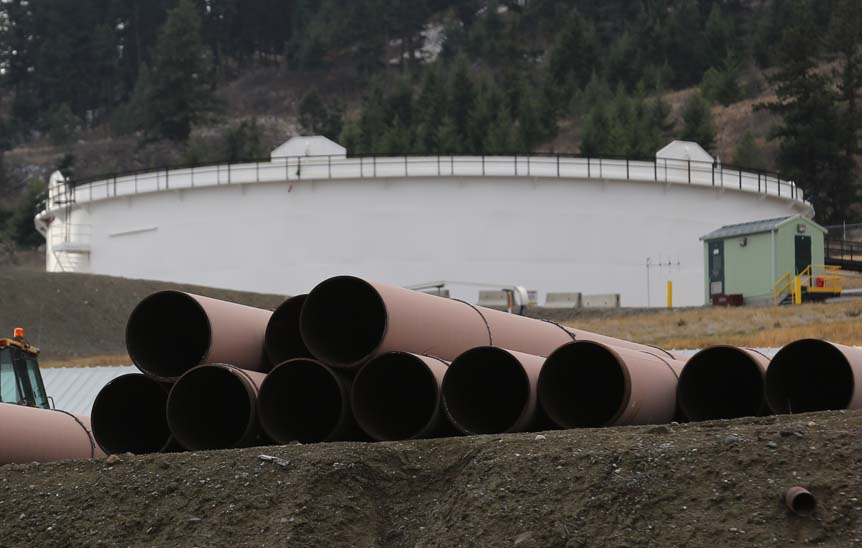Why Canada’s pipeline approval process is such a mess—and how to fix it
Approving major energy projects in Canada is a crazy quilt of overlapping jurisdictions, institutions and policy goals. But a new report suggests a way forward
Replacement pipe is stored near crude oil storage tanks at Kinder Morgan’s Trans Mountain Pipeline terminal in Kamloops, British Columbia, Canada November 15, 2016. (Chris Helgren/Reuters)
Share

An interprovincial battle is brewing over the Trans Mountain pipeline. The British Columbia NDP and Green Party have promised to “immediately employ every tool available to stop the expansion of the Kinder Morgan pipeline.” Alberta Premier Rachel Notley has vowed that the pipeline will be built. The federal government is backing Alberta. Constitutional experts are analyzing all the possible political and legal permutations of how this battle over the pipeline might play out.
It’s worth, though, taking a step back from this constitutional quagmire to consider how we might avoid ending up in this place again.
The Trans Mountain pipeline approval is the result of a broken process—a flawed National Energy Board hearing left intact by the Liberal government. More significantly, however, the pipeline conflict is also the product of an exceedingly myopic process—a federal environmental assessment regime that takes a narrow project-by-project approach to determining how development ought to proceed in light of its potentially harmful environmental impacts. It is a process that has led us to a place in which a major pipeline approval has become the cramped space within which we debate climate policy, coastal protection and Indigenous rights.
While B.C. and Alberta are butting heads, the federal government is in the process of preparing new environmental legislation to be tabled sometime later this year. It has at its disposal a set of ambitious and forward-thinking recommendations in the Expert Panel Report, Building Common Ground: A New Vision for Impact Assessment in Canada. This report contains a wealth of ideas for improving environmental assessment in Canada (some are highlighted here). But two more subdued recommendations ought to receive careful attention from the federal government in light of the current pipeline clash.
The Expert Panel recommends that the new federal legislation provide for a tiered assessment process, which has the potential to flag potential conflict at the outset, before special interests become entrenched. This tiered process would deploy higher-level assessment and planning processes to assess core concerns about development directly and flexibly, rather than through the narrow lens of an individual project.
The first of these tools, regional impact assessment (RIA) assesses the full range of potential impacts for a particular region (the range of stressors in the high-traffic Burrard Inlet, for example). The second, strategic impact assessment (SIA), is a flexible tool that can assess entire industry sectors or federal policies. For example, the Panel recommends a specific SIA on climate change to determine how to integrate greenhouse gas emission targets into federal government decision-making. Both assessment tools allow for a more comprehensive assessment of sustainability: e.g. the cumulative environmental impacts already experienced in a heavily-developed region, or a systemic consideration of industry competitiveness under a new federal policy.
MORE: Canada is a federation of frenemies—and pipeline politics prove it
Importantly, both RIA and SIA happen well before specific project assessment and approvals. If done well, these front-end assessments will clarify which proposed projects have the potential to contribute to sustainability and which do not. They can allow for robust public input on issues of critical importance to communities before companies have invested heavily in developing specific project proposals. And they can facilitate a more rational discussion of energy and climate policy in the country. As the Report notes, a tiered approach allows for proper assessment of sustainability in each case while also making the ultimate project assessment process far more efficient.
Today’s interprovincial clash over the Trans Mountain pipeline reveals that a pipeline is not just a pipeline. Tomorrow’s new environmental assessment legislation ought to reflect that. It ought to properly situate pipelines–and other proposed development projects—within their broader environmental and social contexts. By creating an essential role for regional and strategic assessment in the new legislation, the federal government can ensure we focus more on sustainability and less on pipeline politics.
Jocelyn Stacey is an Assistant Professor at the Peter A. Allard School of Law, University of British Columbia, where her research focuses on Canadian environmental and administrative law.
MORE ABOUT PIPELINES:
- Why it’s time to rethink pipeline protests
- Trudeau welcomes possible steel exemption for Keystone XL
- TransCanada renews Keystone XL application
- Trudeau town hall in Winnipeg faces pipeline protesters
- Trump’s bulldozer diplomacy meets pipeline politics
- We can’t build pipelines and meet our climate goals
- How to kill the Trans Mountain pipeline
- Pipeline debate grips AFN meeting